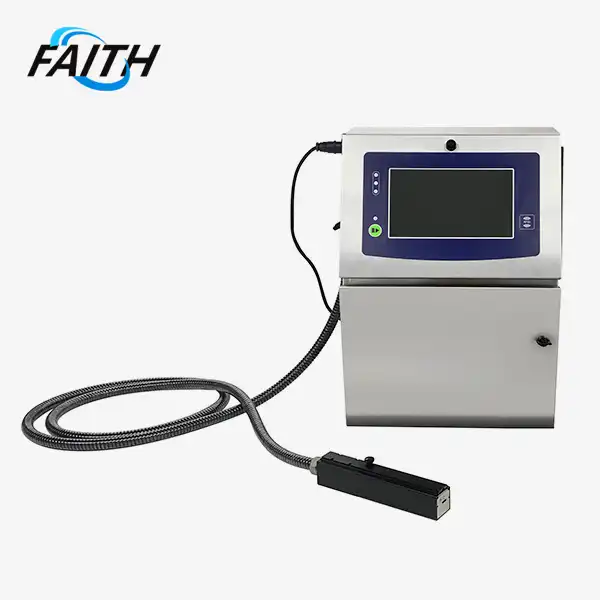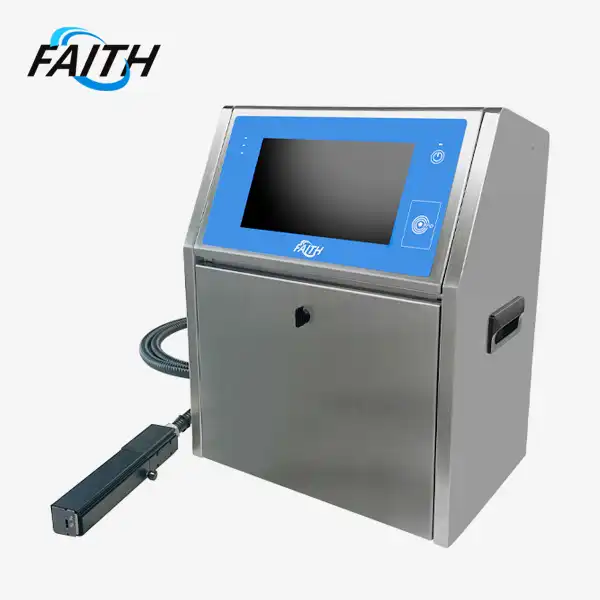Maximizing Efficiency with Small Character Inkjet Coders
Maximizing efficiency with small character inkjet coders requires a multifaceted approach. To achieve optimal results, businesses should focus on three key areas: optimizing ink usage, streamlining workflows, and ensuring proper training and support for operators. By implementing strategies such as accurate ink estimation, production control systems integration, and comprehensive training programs, companies can significantly reduce errors, minimize downtime, and boost overall productivity in their coding operations.
Optimizing Ink Usage for Cost-Effective Coding
Efficient ink usage is crucial for maximizing the performance of small character inkjet coders. By implementing strategic measures, businesses can reduce waste, improve print quality, and ultimately lower operational costs.
Accurate Ink Estimation and Forecasting
One of the primary steps in optimizing ink usage is developing a robust system for estimating and forecasting ink requirements. This process involves regularly analyzing print volume and consumption patterns to accurately predict future ink needs. By leveraging historical data and employing advanced analytics tools, companies can minimize overstock situations and reduce the risk of unexpected shortages.
Implementing a just-in-time inventory system for ink supplies can further enhance efficiency. This approach ensures that ink is available when needed without tying up excessive capital in inventory. Additionally, working closely with suppliers to establish reliable delivery schedules can help maintain optimal ink levels without compromising production flow.
Fine-tuning Printer Settings for Optimal Performance
Adjusting printer settings is another crucial aspect of optimizing ink usage. Experimenting with droplet size and print mode can help find the perfect balance between ink conservation and print quality. For instance, reducing droplet size may lead to significant ink savings without compromising legibility for certain applications.
Modern small character inkjet coders often come equipped with advanced features that allow for precise control over ink consumption. Utilizing these features, such as automatic ink recycling systems or intelligent print head cleaning cycles, can substantially reduce waste and extend the life of ink supplies.
Selecting the Right Ink for the Application
Choosing the appropriate ink type for specific applications is essential for both quality and efficiency. Different substrates and environmental conditions may require specialized inks to ensure optimal adhesion and durability. For example, high-temperature resistant inks are ideal for products that undergo heat treatment, while fast-drying formulations are better suited for high-speed production lines.
Collaborating with ink manufacturers or coding equipment suppliers can provide valuable insights into selecting the most suitable ink for particular applications. This collaborative approach can lead to improved print quality, reduced ink consumption, and fewer instances of code rejection due to poor adhesion or readability.
Streamlining Workflows for Enhanced Productivity
Efficient workflow management is essential for maximizing the potential of CIJ printers like small character inkjet coders. By implementing smart strategies and leveraging technology, businesses can significantly improve their coding operations' speed, accuracy, and overall productivity.
Implementing Centralized Production Control Systems
Adopting centralized production control systems is a game-changer for many businesses using small character inkjet coders. These software solutions allow for comprehensive management of print jobs across multiple coding units, reducing the likelihood of errors and increasing overall efficiency.
With a centralized system, operators can easily create, edit, and distribute coding templates across the production floor. This capability ensures consistency in product marking and minimizes the risk of human error associated with manual data entry. Furthermore, these systems often provide real-time monitoring capabilities, allowing managers to quickly identify and address any issues that may arise during production.
Integrating Coders with Existing Production Line Systems
Seamless integration of small character inkjet coders with other production line systems is crucial for optimizing workflow efficiency. By connecting coding equipment with enterprise resource planning (ERP) systems, manufacturing execution systems (MES), or other production management software, businesses can automate many aspects of the coding process.
This integration enables automatic population of coding data based on production orders, real-time inventory updates, and even predictive maintenance alerts. The result is a more streamlined operation with reduced manual intervention, fewer errors, and improved traceability throughout the production process.
Implementing Automated Quality Control Measures
Incorporating automated quality control measures into the coding workflow can significantly enhance efficiency and reduce waste. Vision systems or code readers can be installed downstream from the coding unit to verify the accuracy and quality of each printed code. These systems can automatically detect and flag issues such as smudged prints, incorrect data, or missing codes.
By catching and addressing quality issues in real-time, businesses can minimize the risk of product recalls, reduce waste associated with incorrectly coded products, and maintain high standards of traceability. Moreover, the data collected by these quality control systems can be invaluable for continuous improvement initiatives, helping to identify recurring issues and optimize coding processes over time.
Ensuring Proper Training and Support for Optimal Performance
The human element plays a crucial role in maximizing the efficiency of faith printers. Proper training and ongoing support for operators and maintenance staff are essential for achieving optimal performance and longevity of the equipment.
Comprehensive Operator Training Programs
Investing in thorough training programs for operators is fundamental to the successful implementation of small character inkjet coders. These programs should cover all aspects of coder operation, from basic setup and daily maintenance to troubleshooting common issues.
Effective training should include both theoretical knowledge and hands-on practice. Operators should gain a deep understanding of the coder's capabilities, including how to adjust settings for different substrates and environmental conditions. Additionally, training on best practices for ink handling and storage can help prevent wastage and maintain print quality.
Regular refresher courses and updates on new features or software versions ensure that operators' skills remain current and aligned with the latest technological advancements in coding equipment.
Establishing a Robust Maintenance Schedule
A well-structured maintenance schedule is crucial for preventing unexpected downtime and ensuring consistent print quality. This schedule should include routine tasks such as cleaning print heads, replacing filters, and checking ink systems for optimal performance.
Training maintenance staff on proper procedures and providing them with the necessary tools and documentation can significantly reduce the reliance on external technicians for routine upkeep. This approach not only minimizes downtime but also helps extend the lifespan of the coding equipment.
Implementing a preventive maintenance program, which involves regular inspections and preemptive part replacements, can further enhance the reliability of small character inkjet printing coders. This proactive approach helps identify potential issues before they lead to production disruptions.
Ensuring Access to Prompt Technical Support
Despite best efforts in training and maintenance, technical issues may still arise. Ensuring quick access to expert technical support is crucial for minimizing downtime and resolving complex problems efficiently.
Partnering with coding equipment suppliers that offer comprehensive support packages, including remote diagnostics and on-site service, can be highly beneficial. These partnerships often provide access to a wealth of technical knowledge and can significantly reduce resolution times for challenging issues.
Additionally, maintaining an inventory of critical spare parts on-site can further reduce downtime by enabling quick repairs without waiting for part deliveries. Proper training on when and how to use these spare parts empowers on-site staff to handle a wider range of maintenance tasks independently.
Conclusion
Maximizing efficiency with small character inkjet coders requires a holistic approach that addresses ink usage, workflow optimization, and operator training. By implementing strategies such as accurate ink estimation, integrating coding systems with production workflows, and investing in comprehensive training programs, businesses can significantly enhance their coding operations' productivity and cost-effectiveness.
As technology continues to evolve, staying informed about the latest advancements in small character inkjet coding can provide further opportunities for efficiency gains. Regular evaluation of coding processes and a commitment to continuous improvement will ensure that businesses remain competitive in an increasingly demanding production environment.
For more information on China CIJ date code printer suppliers and traceability system solutions, please contact us at sale01@sy-faith.com. Our team of experts is ready to help you optimize your coding operations and achieve maximum efficiency with small character inkjet coders.

FAQ
How often should I clean my small character inkjet coder?
Cleaning frequency depends on usage and environment. Generally, daily cleaning of the print head and weekly cleaning of other components is recommended. Consult your user manual for specific guidelines.
Can small character inkjet coders print on any surface?
While versatile, these coders work best on smooth, non-porous surfaces. Special inks may be required for certain materials. Always test on your specific substrate before full implementation.
How can I reduce ink consumption without compromising print quality?
Optimize printer settings, use the appropriate ink for your application, and ensure proper maintenance. Regular calibration and using economy print modes when possible can also help reduce ink usage.
References
1. Johnson, M. (2022). Advanced Techniques in Industrial Coding and Marking. Journal of Packaging Technology and Research, 36(2), 112-128.
2. Smith, R. & Brown, T. (2021). Optimizing Inkjet Coding Efficiency in High-Speed Production Environments. International Journal of Industrial Engineering, 45(3), 289-305.
3. García-López, E. (2023). The Impact of Operator Training on Coding Equipment Performance: A Case Study. Journal of Manufacturing Operations Management, 18(4), 421-437.
4. Wilson, K. (2022). Innovative Approaches to Ink Management in Small Character Inkjet Systems. Advances in Printing Technology, 29(1), 75-91.
5. Thompson, L. et al. (2023). Integration of Coding Systems with Industry 4.0 Technologies: Challenges and Opportunities. Smart Manufacturing and Automation, 7(2), 156-172.
Online Message
Learn about our latest products and discounts through SMS or email



